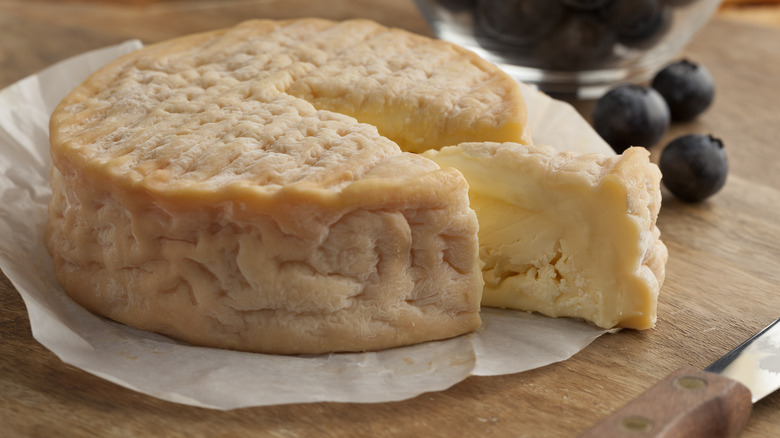The Reason Époisses Cheese Is Illegal In The US
When you're planning a grazing spread for your next get-together, there are myriad factors that you'll want to take into consideration. Of course, things like freshness, availability, and how disparate flavors work with one another are all going to influence your picks. But above everything else, you'll want to make sure that your snack selection won't make you spend a stint in the slammer. For example, Époisses cheese, a French delicacy from Burgundy first fermented in the early 1500s, is forbidden in the United States ( at least importing it, that is).
This prohibition is due to the potential that the cheese has to develop harmful bacteria. It starts its life as raw (unpasteurized) milk, and it is then left to age and develop flavorful, safe-to-eat bacteria. However, according to the USDA, there is also the potential for dangerous bacteria to develop, some of which can carry a slew of infections that, in the worst cases, can be life-threatening. Despite this, many people decide to eat Époisses anyway and enjoy its fruity tang, which is rounded out by flavor notes like mushroom and even farm animal. The U.S. Food and Drug Administration feels the risks of eating cheeses like Époisses outweigh their pleasantly pungent taste profiles.
The reasons for Époisses' illegality
Even in France, Époisses cheese is probably not a common sight in most refrigerators. It is arguably one of the smelliest cheeses on Earth, but the offensive odor isn't the reason why it's illegal stateside. The U.S. Food and Drug Administration has strict regulations regarding the sale and import of cheeses made with unpasteurized milk — specifically, any cheeses that have been aged for less than 60 days are banned.
The reason for this and other time-based restrictions is that, as cheese ages, it develops salts and acids that can better fight off harmful bacteria. Époisses cheese is generally aged for less time than the 60-day mark, so it has the potential to develop pathogens like listeria and E. coli. The former infects roughly 1,600 people annually, and kills around 260 every year, according to the CDC. The elderly and other immunocompromised populations are the most affected.
A cheese can only bear the name Époisses if it is made with raw milk. Despite this, you can find varieties made in the United States that are made from the pasteurized version of the product, but the culinarily inclined are quick to point out that a pasteurized piece of Époisses is far less tasty, and has less complex flavor profile.
Eating Époisses in the US
You may still want to avoid Époisses at all costs, but there are a number of arguments in favor of the funky French cheese. For starters, pasteurized milk may be more prone to developing dangerous bacteria. Dr. Catherine Donnelly, a microbiologist at the University of Vermont, has posited that the aforementioned listeria is far more prevalent in pasteurized milk cheeses.
Additionally, there are plenty of raw milk cheeses that are common in the United States, though they all pass the 60-day aging mark. This includes Gruyère and Parmigiano-Reggiano. Softer raw milk cheeses, like Camembert, are only available in the U.S. when they've been aged more than 60 days, and as such, are not the genuine article.
In 1999, two people died after eating Époisses contaminated with listeria. The plant that made the infectious Époisses was shut down, but the subsequent investigation revealed that the cheese in question may not have been Époisses at all, legally, as it may have been made from pasteurized milk. Several other deaths have also been linked to Époisses consumption in the years since, but many French people ardently defend the production of unpasteurized cheeses, arguing that it is a fixture of French society. Cheesemakers have even suggested that the infection fear has been exacerbated by the U.S. dairy industry. Still, if you come across a pasteurized wheel at your local market, there's no need to turn your nose up at it (smelly as it may be).


